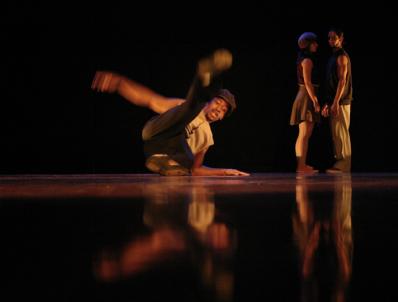Take it Back - joy explosion

Four young dancers pose with the serious beauty of those who respect the eye of the camera, or in this case the audience. Their costumes are fifties-style street clothes, the two women in dresses and two men in jazz-casual suits, yes, ready for attention, ready to perform. Beat. Still ready. So ready that the tall woman's broad smile (JoDee "Fiesty" Allen's irrepressible grin) begins to freeze.
Though the groovy swing music by Les Mains Librethat opens *Take it Back* is catchy, the four remain perfectly still. Until Allen slides her left leg slowly out of her pose, her body looking for a way out of this boredom-lock, hungry to move to the music. Umm, can we dance now? her muscles ask. And then she slips free completely, eases into a few steps, grasps her freedom and erupts into a breakdance routine. The joy of it!
Joyfulness doesn't take well to being stared down, however. When Allen glances over and sees the unimpressed, skeptical faces of her crew - Helen "Cheeco" Simard, Joe-Danny "Dingo" Aurelian Guy-Robert Jean - she stops and returns to her place. Temporarily. Soon, she bursts out of stillness a second time, and this time she's willing to take the rejection that dancing "out of line" brings. She spins and curls, pausing every couple of seconds to strike a pinup-girl pose. The effect is hilarious because her body is completely untamable and yet malleable, able to conform but anarchic enough to resist conformity. Like many women, Allen can inhabit the “sexy object” role if she wishes - but she doesn’t want to be forced to stay there.
As you can tell from that description, the choreography by Montreal's Solid State (Allen and Simard) sets up questions about gender - who has "permission" to do what and when. They also present questions about leading or following: does anything happen if no one makes the first move, or, conversely, is anyone willing to follow instead of taking the solo role that breakdancers inhabit in their competitions?
Once these questions are sketched, they are wisely left to hover as the backdrop. The dancing really takes off, and take it Back becomes a vivid, engaging and stylish mash-up of street dancing and jazz dance, breakdance and the Lindy Hop, the Charleston and jive and even a peppering of disco. There are surprising moments of capoeira contests between the two women. There's a hilarious nightclub scene that encompasses perfectly the way some dance floors are arenas for cool, ultimately insecure staredowns. And truly wonderful are the moments when the group blends breakdancing with moves from the dances of other decades, combining street dance spins with swing dance dips or a few phrases from tango.
Allen and Simard two founded Solid State company in 2000 with a focus on supporting women in breakdancing, but the group has grown to incorporate all sorts of street dance. Increasingly, they seek situations that allow for odd combinations of styles. For example, they took breakdancing to the "2007 Montreal Chamber Music Festival":http://www.youtube.com/watch?v=g8QmjPeisPY performing to Bach. In that performance, as in Take it Back, the unusual context means that dance steps can be slowed down or sped up, or moves can be broken apart and reassembled into new patterns. Similarly, the soundscape by Les Mains Libres moves between straightforward replays (of Nina Simone's Sinnerman, for example) and reconfigured jazz or swing standards (including a pumping techno version of Ella Fitzgerald singing "It don't mean a thing (If it ain't got that swing)."
On still another level, Take it Back's push-back against constrictions of gender and leader/follower roles is reminiscent of the way different kinds of dance have been outlawed, forbidden or restricted over the centuries. From capoeira (created by African slaves in Brazil as a way to keep their culture plus stay fighting-fit) to the Argentinian tango (birthed by poor dock workers in Argentina, and for a while a forbidden dance to that country's upper classes) to raves being restricted our illegalized in the '90s around North America and Europe, the exuberance of dance has caused suspicion in a surprising number of cultures over many centuries. (A great blog with plenty of current and historical examples of this can be found "here":http://history-is-made-at-night.blogspot.com/)It's usually the dance from lower classes, or from "foreigners" that causes trouble - until the dance becomes a hit, and the anarchy it implies is domesticated. Hip-hop itself is an example of that domestication, in a way, as the form is now taught in places that range from high school phys ed to community-centre fitness classes. As each formerly anarchic dance form becomes tamed, new fusions - new combinations - need to be found to regenerate the proud, inquisitive energy of non-classical dance. That's one thing Solid State is doing with their recontextualizations.
All four dancers in Take it Back are fluid, energetic performers who bring deep skills and obvious pleasure to the stage. The exuberance of the body - the way music has pulled humans into dancing for pleasure probably since the first notes were sung or drummed - is alive and well in Solid State's world. It seems like Allen, Simard, Aurelian and Jean could dance for another two hours. But they close their performance by selecting a guy and a gal from the audience, forming three couples that dance comfortably, happily, on the stage. It is simple, it is beautiful, it is a generous way to end, reminding us all to dance for the love of it, trained or untrained as our bodies may be.
Take it Back (Solid State, Montreal) is a Dancing on the Edge 20th Anniversary Festival presentation. Choreographers: JoDee "Fiesty" Allen and Helen "Cheeco" Simard; Performers: Helen "Cheeco" Simard, Joe-Danny "Dingo" Aurelian and Guy-Robert Jean; Music: Les Mains Libres



